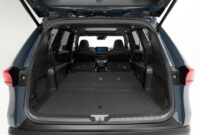Since the DGT environmental labels were born almost five years ago, we knew that they were going to be the ideal tool for the instrumentalization of future restrictions on movement. And so it has been. In 2023, ZBEs that have done their homework will come into operation, and many media are talking about the restrictions on movement that they will entail. Curiously, many comment that the cars with label B they will have to Mandatory parking in parking lots already in 2023. Fortunately, this it isn’t true.
You should not believe everything that is read at face value, and on this occasion, it seems that we are facing a combination of hoax, misinformation and headlines that seek the click. Let’s go in parts, but let’s make something very clear from the beginning: There is no regulatory precept or law that obliges cars with the B label to park in a parking lot when driving through a low emission zone. B-labeled cars are abundant on our streets and highways, and will certainly be the first to be restricted in the future.
There is no regulation that obliges, in 2023, that the label B have to park in a car park inside the ZBE.
However, cars with a B label can get rid of the restrictions on movement that are imposed at the national level on cars without a label when driving in low emission zones. And I emphasize that “they can get rid of”, because we must remember that the design of the 150 low emission zones that should be working in Spain by January 1 – spoiler, only 20 of 150 will be working – is municipal competition. Namely, each of these 150 ZBE will be different in extension, schedules or restrictions.
This fragmentation will cause not a few headaches and we know that the confusion resulting from its heterogeneity will be fantastic for the municipal coffers. But at the same time, this fragmentation will make some LEZs are much less restrictive than others. At this point, I want to inform you (or rather, remind you) of the existence of a document called “Guidelines for the creation of low emission zones (ZBE)”published in 2021 by the Ministry for the Ecological Transition and the Retro Demographic (MITECO).
The design of the ZBE, its restrictions, extension, schedules and exceptions, is a municipal responsibility.
Aimed at town halls and municipalities, this document discusses the ideal ways to create a ZBE, and which restrictions are the most effective in reducing the use of private transport, the ultimate goal of all ZBEs. Not even in the section dedicated to parking criteria – nor anywhere in the Climate Change Law – does it mention forcing cars with a B label to park in a parking lot. However, a city council could raise this obligation when designing your LEZ.
In fact, This is what is already happening in Madrid Central, the first LEZ in Spain. Introduced by Manuela Carmena’s executive and perpetuated by Almeida’s team, Madrid Central obliges non-residents and, in general, any vehicle without an ECO or ZERO label to park in a car park to avoid a 90-euro fine. In some cities, unlabeled vehicles have already been prohibited from parking in their ORA/SER zones. But I insist once again, it is an optional decision of each city council to introduce this type of restrictions.
A council could prohibit certain vehicles from parking in its SER/ORA zones. But it is an optional decision.
And at least until May, you can breathe easy when it comes to traffic and parking restrictions. Although the ZBE should be active on January 1, in a few months there are municipal elections. Many municipalities will decide to “postpone” the commissioning of their LEZs until then – coincidentally.







